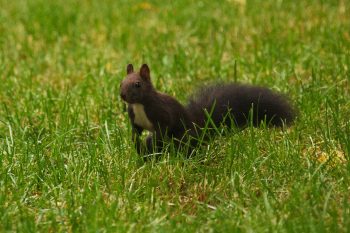Wild Danish Mammals Posted by Bjørn A. Bojesen on May 30, 2019 in Uncategorized
A hare [ha-a] jumping mysteriously across the street in front of you. A ræv (fox) stealing your sausages at the beach barbecue party. A pindsvin (hedgehog) going for a moonlit stroll. As urban as Denmark is, the country has a lot of wildlife. 🙂
The Vikings believed in Ratatosk, an egern [e-yern] (squirrel) that was constantly running up and down the world-tree, Yggdrasil, to spread news and gossip. Visit Kongens Have (King’s Garden) or another Copenhagen park, and there’s a good chance you’ll meet one of Ratatosk’s descendants! Sød, ikke? (Cute, right?)
There are two kinds of egern in Denmark, røde (red ones) and sorte (black ones). The black squirrels came here thousands of years before their ginger friends, but are actually very endangered now in 2019! If you see one, treat it kindly. 🙂
In the top of the world-tree, the Vikings also believed, four hjort/e [yort/eh] (deer) were busy eating leaves. While I doubt you’ll find a hjort in a tree in the park, you might catch a glimpse of one in a Danish skov [skow] (forest). The kronhjort (red deer, literally ”crown deer”) is the biggest land animal in Denmark. There are also the smaller rådyr (roe deer) and dådyr (fallow deer). The female deer is generally called a hind [hinn], and the kid is called a kalv (”calf”). Only the males have gevir [ge-VEER] (antlers) – don’t get too close, or they might stange (butt) you. (Normally, though, Danish deer are only aggressive in the short mating season – brunsttiden – or when they have small kids.)
Have you ever seen a grævling (badger)? Few Danes have, but they are out there somewhere, hiding in their underground burrows. The Danish word for ”to dig” is at grave – see the connection? 🙂 A grævling is literally a gold…, I mean, just a digger!
Of course, in Denmark you can also find other pattedyr (mammals) such as odder (otter), mår (marten), mus (mice), rotter (rats), flagermus [flower-moose!] (bats)… And when you least expect it, sæler (seals) and marsvin (porpoises) will look at you from the ocean waves.
Some oldies have been reintroduced into dansk natur (Danish nature). Even though the last vildsvin (wild boar) was shot by a hunter in 1801, there are now several places where you can see the big wild pigs – safely through a hegn [hine] (fence). There even have been experiments to bring back bæver/e (beaver/s) and elg/e (elk/s) to Denmark. And did I tell you we’ve got ulv/e (wolves)? 🙂

Build vocabulary, practice pronunciation, and more with Transparent Language Online. Available anytime, anywhere, on any device.






Comments:
JORGE ALEXANDRE DE SOUSA GOMES:
Aw, that is my favorite so far :-)! Tak skal du have for det!
Bjørn A. Bojesen:
@JORGE ALEXANDRE DE SOUSA GOMES Mange tak @Jorge! 🙂 Glad to hear.